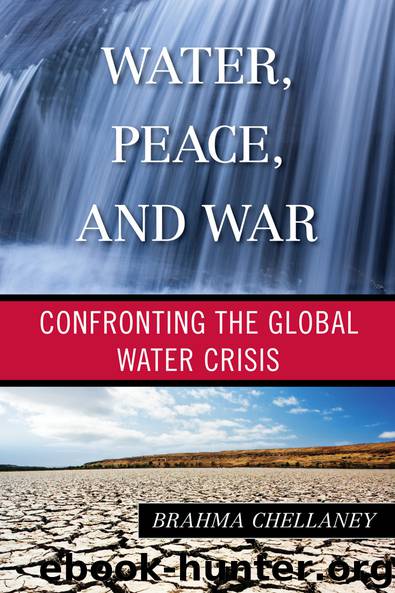Water, Peace, and War by Brahma Chellaney

Author:Brahma Chellaney [Chellaney, Brahma]
Language: eng
Format: epub
Publisher: Rowman & Littlefield Publishers
Published: 2013-09-14T16:00:00+00:00
Map 4.1. Rivers of the Indus System, and the Treaty Line Partitioning Rivers
Despite the treaty, the two countries’ festering territorial feud over Jammu and Kashmir and their complex internal water and political dynamics have hampered cooperative efforts and sharpened their water rivalry. Water is the only natural resource amply found in the otherwise resource-poor Indian part of Jammu and Kashmir. So, the gifting of its river waters to Pakistan by treaty has fostered popular grievance there over the denial of a resource essential for development—a situation compounded by a Pakistan-abetted Islamist insurrection in the Muslim-dominated Kashmir Valley against Indian rule. The water issue has triggered a long-simmering backlash in the Indian part, where many at the grassroots feel alienated from mainstream India, and prompted its elected legislature to call for revision or abrogation of the treaty.
Estimates of the economic losses incurred by the Indian part due to the treaty-imposed fetters on water utilization run into hundreds of millions of dollars per year.30 India’s belated moves to address the problems of electricity shortages and underdevelopment in its restive part by building modest-size, run-of-river hydropower plants on the three main Jammu and Kashmir rivers, however, have whipped up political passions in downstream Pakistan, although such treaty-sanctioned projects involving no reservoir storage are unlikely to materially alter transboundary flows. Run-of-river plants, as explained in chapter 2, use a river’s natural flow energy and elevation drop to produce electricity, with their water inflows and outflows virtually the same.
The India-Pakistan water equation has been made murkier by China’s construction of large dams and other strategic projects in an internationally disputed area—Pakistan-administered Kashmir, including close to Pakistan’s cease-fire line with India. This has drawn protests not just from New Delhi but also from the communities in the dam-building areas, located mainly in the northernmost Gilgit-Baltistan region. China, in addition, has built dams in Tibet on the two Indus-system rivers that originate there—the Sutlej and the main Indus stream—and further damming activities by China could alter the region’s cross-border flow patterns in the dry season. Both in the Pakistani and Indian parts of Jammu and Kashmir, local communities want to have greater control over their water resources.
The resistance to new dams in the Shiite-dominated Gilgit-Baltistan—one of several factors that have brought units of the People’s Liberation Army into this thinly populated but rebellious Pakistani Kashmir region—is because these projects uproot local residents and benefit only the downriver province of Punjab, which dominates the economy and military of Pakistan, a mainly Sunni state. Pakistan has awarded to Chinese companies new megaprojects in Gilgit-Baltistan like the mammoth 7,100-megawatt Bunji Dam. The fact that China rules Gilgit-Baltistan’s Shaksgam, Raskam, Shimshal, and Aghil valleys—ceded by Pakistan in 1963 to cement its strategic alliance with Beijing—has only added to the grassroots resistance against Chinese projects, which extend to mineral-resource extraction and new transportation links.
The Pakistani government has responded harshly to such opposition in Gilgit-Baltistan, tightening its direct military rule over the area. It even banned a book by local intellectual Muhammad Saeed
Download
This site does not store any files on its server. We only index and link to content provided by other sites. Please contact the content providers to delete copyright contents if any and email us, we'll remove relevant links or contents immediately.
The Secret History by Donna Tartt(18857)
The Social Justice Warrior Handbook by Lisa De Pasquale(12143)
Thirteen Reasons Why by Jay Asher(8800)
This Is How You Lose Her by Junot Diaz(6800)
Weapons of Math Destruction by Cathy O'Neil(6149)
Zero to One by Peter Thiel(5691)
Beartown by Fredrik Backman(5603)
The Myth of the Strong Leader by Archie Brown(5429)
The Fire Next Time by James Baldwin(5251)
How Democracies Die by Steven Levitsky & Daniel Ziblatt(5132)
Promise Me, Dad by Joe Biden(5088)
Stone's Rules by Roger Stone(5027)
A Higher Loyalty: Truth, Lies, and Leadership by James Comey(4851)
100 Deadly Skills by Clint Emerson(4845)
Rise and Kill First by Ronen Bergman(4705)
Secrecy World by Jake Bernstein(4652)
The David Icke Guide to the Global Conspiracy (and how to end it) by David Icke(4629)
The Farm by Tom Rob Smith(4442)
The Doomsday Machine by Daniel Ellsberg(4420)
